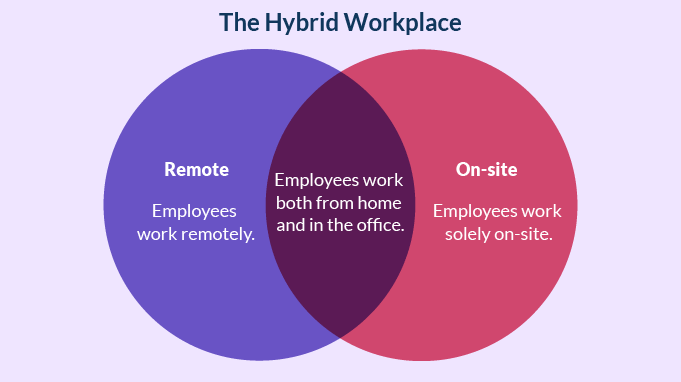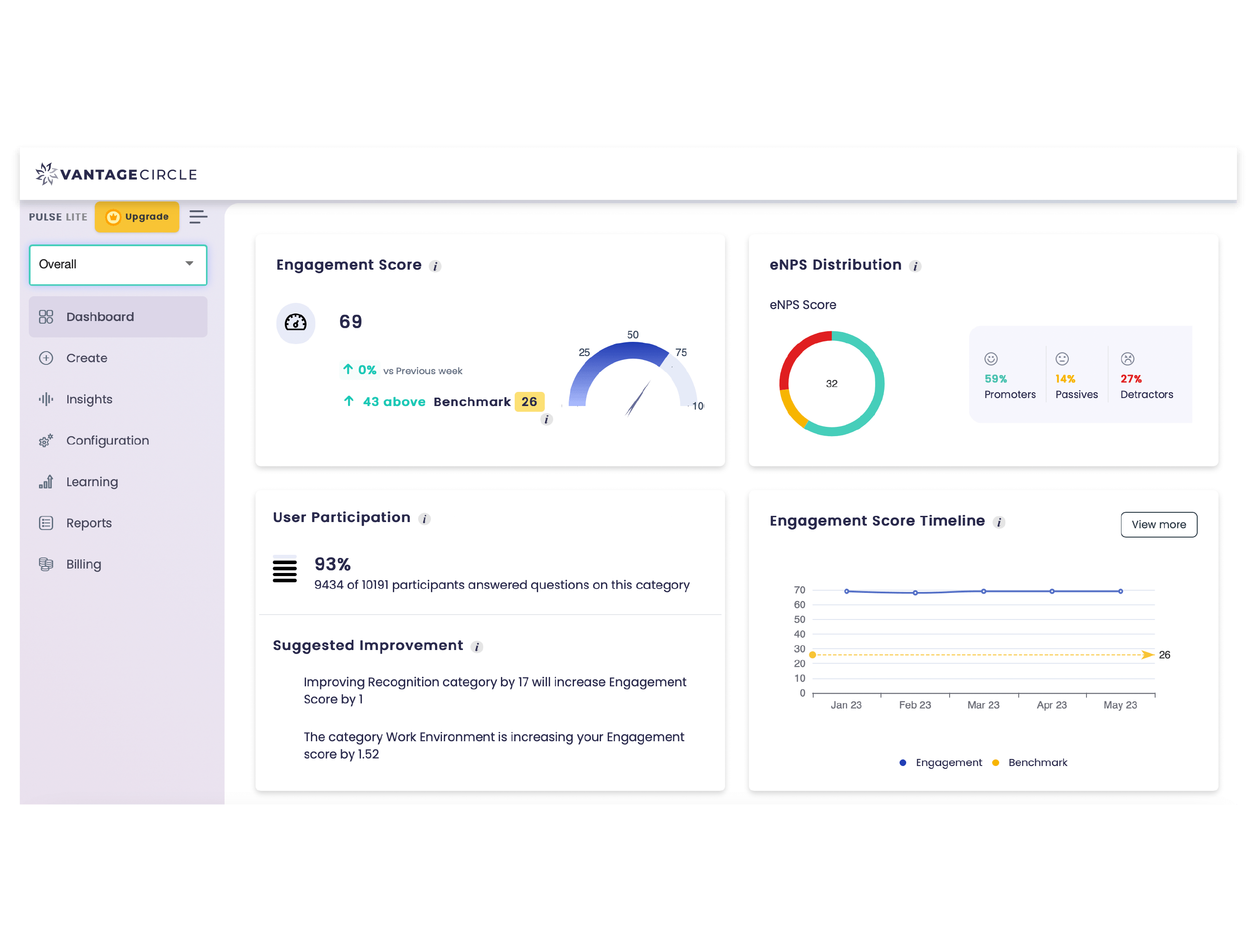The Evolution of Work: Unveiling 10 Hybrid Workforce Best Practices
With the emerging need and popularity of a hybrid work arrangement, many of you are definitely curious to learn about this drastic shift in work arrangement. Along the lines of curiosity, a sense of confusion has also taken over. You may be questioning what comprises a hybrid workforce in particular.
So, to be very precise, a hybrid workforce is a blend of a workforce where-
- A section of employees work exclusively from remote locations.
- Another section of employees works exclusively at a physical office.
- Employees who work in the office have the flexibility to split their time between onsite and remote work. For example, working 3 days from the office and 2 days remotely, or vice versa.

Workers have the flexibility to assess their optimal productivity environments. They can accordingly opt for either one of them or a blend of both, depending on their preferences.
Key Takeaways
- What led to the rise of hybrid work arrangement
- What are the challenges haunting the hybrid workforce
- What are the best practices for the smooth functioning of a hybrid workforce
Now, What led to the Rise of such a Work Arrangement?
Even though technology had already set the stage for a flexible work environment, the pandemic truly pushed for a change. Instead of bringing work to a standstill, this setup proved to be well-suited for dealing with a challenging situation.
The pandemic paved the way for blending remote and on-site workforce, hence giving birth to the hybrid workforce. And since employees found the flexibility they sought with this new arrangement, it carved its path to longevity.
Coming out of the pandemic has made organizations realize that employees like the idea of deciding where and when they wish to work. The flexibility that a hybrid work model offers is lucrative to people seeking a healthy work-life balance.
According to a study conducted by Pew Research, 55% of employees claim that they prefer to work from home for atleast 3 days per week.
55% of respondents from a study by Stanford want to spend some time in the office and some time at home.
These statistics shed light on the increasing demand for hybrid workplace arrangements. It would not be wrong to say that these figures give weightage to the notion supported by several managers that hybrid working is here to stay.

Source: Career Guide, Gartner
McKinsey predicts that nine out of ten organizations will combine remote and on-site working in the upcoming years. As hybrid working gears up as the most sought-after work model, organizations must ponder whether they are ready for the massive changes impacting HR processes and leadership practices for the future workforce.
However, introducing a hybrid workforce is one thing, and deriving success from it is different. Creating a successful hybrid workforce does not happen as thought. It takes a significant amount of time for the transition to happen.
To master anything, you require practice. A hybrid workplace is no exception. It does have its share of benefits that help you improve employee productivity, assist in real estate cost savings, increase workplace satisfaction, etc.
However, your approach may take a declining turn if you are not cautious and do not address the challenges. Reaping the benefits will require you to take the necessary practices that we will go through later in this blog.
A Peek into the Challenges Haunting the Hybrid Workforce

But before we dive into the practices, understanding the challenges will give you a clear picture involved with it.
Challenges are inevitable in any form of practice, and hybrid arrangement is no different. Addressing these challenges is crucial for ensuring the success of a hybrid workforce.
Communication Barriers

A hybrid work setting is commonly faced with communication struggles arising from -
-
Fragmented conversations across different mediums,
-
A lack of consistent information sharing, and
-
Fatigue from daily digital exchanges.
This goes on to open doors for misunderstandings and misinterpretations among coworkers. Additionally, over-dependence on digital communication tools can cut short the possibility of face-to-face interactions.
Technological Insufficiency
As per Deloitte’s survey, about one in five respondents think there is insufficient adoption or change management when introducing a new tool for hybrid working.
The source of communication and collaboration in a hybrid set-up heavily depends on the use of technology.
As a result, managing between office and remote locations requires the provision of the right technological infrastructure, such as laptops, printers, hardware, sound internet connectivity, and collaboration tools.
If an issue erupts in any of these, there will be a definite disruption in work.
Hindrance in Team Collaboration
When the idea of team collaboration comes into the picture, building a cohesive team of trust and bonding with each other becomes central. However, when part of the team is working remotely, the idea of collaboration gets hindered. Coordinating becomes a hefty task, and work gets delayed when not attended to on time.
When the lack of collaboration hinders spontaneous interactions, you tend to push away creativity and problem-solving.
Information Security Issues

When you have employees working at multiple locations remotely, ensuring the security of the data they are engaged in becomes equally important yet challenging.
Remote workers are more susceptible to increased risk of phishing, social engineering, and exposure to unsecured networks. As a result, they likely find themselves trapped in the vicious cycle of cyber threats. As a result, ensuring their safety and security becomes the challenging part.
Unable to Attain Work-life Balance
Both sets of workers have their share of challenges regarding striking work-life balance. Remote work blurs the line between their personal and professional time frame; hence, they are more prone to extend their working hours.
On the other hand, office workers can stick to the time limitation, but they lose half of their time due to long commuting hours.
In addition, employees working remotely might be pushed to loneliness and isolation. And not being able to disconnect from work leads them to burnout.
Challenges in Inclusivity and Equity
There is always a higher chance for onsite workers to be favored over remote employees. On-site workers are more visible regarding their dedication and efforts. On the other hand, remote workers might face situations where the visibility factor creates concerns for them.
Their work is not likely to be starkly visible, which could leave them demotivated and likewise hamper their career advancement opportunities.
Moreover, networking issues due to technological limitations also impede inclusivity.
Distance from Company Culture
Having your remote employees align with the company culture can be as challenging as it seems.
The authentic essence of company culture often manifests during face-to-face interactions, when teammates bond over work, engage in informal conversations, and participate in activities and events. While onsite employees have easy access to these aspects, remote workers face difficulty accessing these facilities.
Battling these challenges will require you to work on various strategies and implement practices. The solutions should be tailored accordingly and be suitable for the workforce.
Without further ado, let us take a plunge into some best practices to ensure a smooth and productive hybrid workforce.
Best Practices for a Smooth Functioning of a Hybrid Workforce

Hybrid work will allow us to achieve the best of both worlds, the focus and collaboration of the office, and the flexibility and autonomy of remote work.
– Tim Cook
The following best practices list will assist you in addressing challenges and ensuring the smooth operation of your hybrid workforce.
1. Clear and Strong Communication Strategies
Until and unless you have communication sorted among your employees, irrespective of location, you will face difficulties in the long run.
Hence, to cater to your remote and in-office employees, you must use mixed communication tools, including video conferencing, instant messaging, and email, to cater to different preferences.
In addition, if you haven’t, you must now be clear to all the employees about establishing guidelines for strengthening communication.
The guideline must clarify communication frequency, and response timings, and specify the use of particular channels for different types of communication.
2. Technology Integration

While hybrid working can represent the best of both working worlds, this shift could require an investment in more sophisticated technology.
– Rahul Goyal
Technology integration should be such that it caters to every workforce, irrespective of location.
Investing in reliable collaboration tools like Google Meet, Zoom, Microsoft Teams, Slack, Google Workspace, etc., will facilitate smooth communication, document sharing, and project management.
Also, ensure you are open to assisting your employees with technical support that allows them to use the collaboration tools effectively.
The technical support team should be adept enough to address any issues promptly and minimize disruptions the employee faces.
3. Flexible Work Policies
According to the statistics conducted by FlexJob, most employers (80%) offer their staff “flex time” work arrangements to give their employees control over their working hours.
Come up with flexible policies that bring out the best in every employee irrespective of their work setting. Also, be sure to articulate these policies that leave no room for confusion. You can implement flexibility in the following manner:
- Formalize a standard work schedule policy, such as 2-3 office days and 2-3 remote days per week for the in-office workers.
- Define daily/weekly core collaboration hours that all employees should overlap online.
- Allow customization of schedule based on role and employee needs.
- Lay more emphasis on clear output expectations rather than being rigid about hourly requirements.
- Ensure all forms of work-related support for productive remote work.
The key here is to normalize a standard hybrid policy that allows flexibility in pursuing their work and optimizing it to a level that helps them deliver the required performance. This will also help you build a culture of trust among employees.
4. Team Building

Team building is crucial to ensure the organization's smooth functioning. Hence, you must engage your employees in team-building activities and help bridge the differences between remote and on-site employees.
Virtual team-building activities would do just the thing to foster camaraderie and collaboration. These activities can include -
- Remote Personality Assessments
- Remote Collaborative Games
- Cross-Functional Meetups
- Digital Team Building Workshops
- Digital ice-breaker activities, etc.
5. Employee Well-being

The primary way to ensure employee well-being is to promote work-life balance. To do this, you must encourage employees to establish clear boundaries between their work hours and personal lives.
The mix of the two must be eradicated. Try limiting their workloads to help them focus and prioritize their well-being.
In addition, try offering resources and support for mental well-being, such as access to counseling services and stress management programs.
These additional efforts will go a long way in helping them pull out of stressful situations.
6. Performance Measurement
This factor is very crucial to establishing a sound work culture. You must be equally clear about all employees' performance expectations, goals, and metrics.
Also, make sure to conduct regular check-ins among the members so that you can discuss progress, exchange feedback, and address the subsequent challenges.
Consistent open discussions leave no space for invisibility. Every performance will be closely monitored and duly recognized for its merits.
7. Professional Development
Professional development should be ensured for both remote and office-working employees by giving them equal opportunities in their professional journey. While the on-site workers get the training facilities in person, the remote workers should be provided with virtual training programs and resources that ensure continuous skill development.
Also, facilitating virtual mentorship programs is the best way to foster professional growth and guidance.
8. Security and Compliance
Ensuring security is undoubtedly challenging. However, you have to take the responsibility to ensure it.
It is always best to start by conducting regular cybersecurity training sessions and inform them about the best practices to help mitigate the risks they are exposed to.
Keep your employees well-versed with the compliance standards and data protection measures that keep them all informed. This will help them become cautious in every step they take in the web world.
9. Feedback Mechanisms

As discovered by American Express, seeking your employees’ feedback from the beginning is crucial. Their help in co-designing your hybrid work approach will ease them in adopting to your change and ensure your hybrid model suits them as best it can.
Feedback is a must to ensure the smooth functioning of everything. Establish a regular feedback system where you can gather input from the employees regarding the effective working of the hybrid model.
In this way, you can figure out the problem associated with the hybrid functioning or anything related to it and try to implement changes according to feedback received from your employees.
And what can be the optimal platform for gathering feedback? Well, out of the many methods to choose from, pulse surveys stand out as the most effective. Consistent use of these surveys enables you to stay updated on your employees' perspectives.Following this, you must showcase active responsiveness by actively addressing and resolving concerns raised by your employees.
If you wish to get a tailored solution to elevate your feedback process, Pulse Platforms can be the suitable solution. You can get access to powerful analytics that help you take actionable insights. It is not a tool but a strategic partner to aid you towards your goal.

Source:Vantage Pulse
10. Inclusive Company Culture
You should come up with policies that practice and ensure inclusivity. This will create equal opportunities for all regardless of the work location. This will make them feel that they are a part of your organization.
Igniting a sense of belonging in every team member will help you maintain an inclusive company culture. Some of the practices to ignite belongingness are as follows:
- Virtual team building activities
- Recognition and appreciation
- Celebrating workplace diversity
- Celebrating milestones
- Inclusive decision-making, etc.
Final Words
It would not be wrong to say that by now, you have garnered a thorough understanding of the rising significance of a hybrid workforce, the set of challenges it poses, and how the best practices can tackle the challenges and deliver suitable results.
Now, it is your turn to utilize this information to carve your path to building a robust hybrid workforce. This approach not only unlocks the potential of your employees but also propels you toward achieving your organizational goals.
FAQs
Why is the hybrid workforce gaining popularity?
The popularity lies in its approach to offering flexibility, promoting work-life balance, and accommodating diverse employee preferences.
What steps can organizations take to transition to a hybrid workforce successfully?
Successful transition involves the following steps:
- Clear communication of policies
- Technology readiness
- Emphasis on employee well-being
- Regular check-ins, and
- A commitment to adapting strategies based on feedback and evolving needs.
How can organizations measure the success of their hybrid work model?
Here are some of the ways through which organizations can measure the success of their hybrid work model:
- Employee satisfaction surveys
- Productivity Metrics
- Retention Rates
- Continuous Improvement Initiatives, and
- Meeting Organizational Goals














